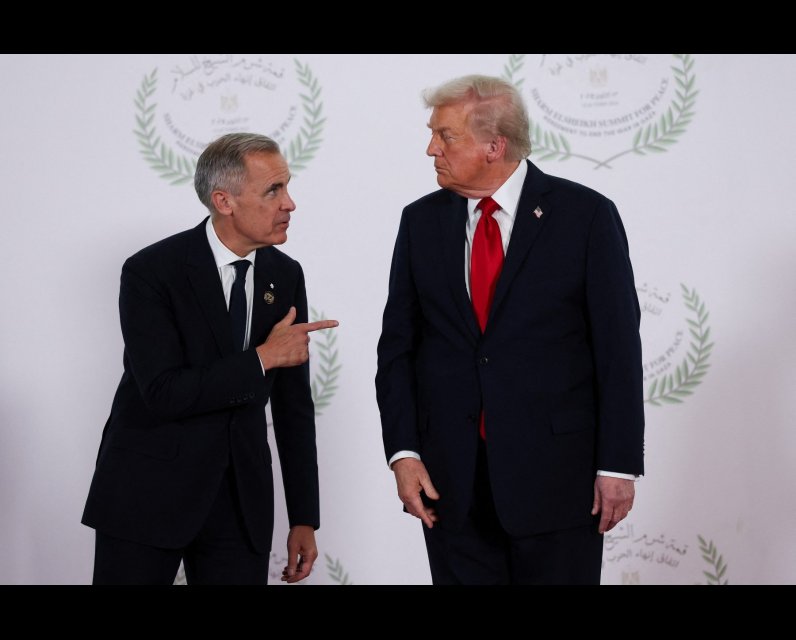Enough of Tactics to Deal with Trump. What Canada Needs Is a Strategy

The United States is in crisis and, therefore, Canada is in crisis. These conjoined crises have common features. Both involve reimagining national strategy, and also questions of federalism. But the similarity ends there.
That the United States faces a “crisis of democracy” is widely acknowledged. It began in the early twenty-first century and accelerated after the global financial meltdown of 2007/08.
Americans are deeply polarized about what has gone wrong with the system and how to fix it. There is a red-state view and a blue-state view. The struggle in Washington has become brutal, as each camp seeks to execute its own vision of a new national strategy and obstruct execution of the alternative vision.
My own diagnosis of the current moment differs somewhat from both red and blue views. The American system as a whole is not in crisis. There are tens of thousands of governments (state, regional, local) in the US, and the overwhelming majority are working as they always have. This is largely a crisis of central institutions, which have proven incapable of managing polarization and are probably making it worse.
I have argued that this crisis is the unintended consequence of decades of centralizing reforms. The architecture of American federalism has changed significantly since the 1930s. The power of national government—Washington—has expanded. At the same time, the power inside Washington has shifted, so that presidents are much more powerful than they used to be.
This bipartisan project of centralization proceeded on the assumption that regional and ideological differences inside the US were fading away. If most people were on the same page, then it would be easier for Washington to make decisions on a broader range of topics. At the same time, people on the losing side of national elections would be unhappy but not distressed by the outcome.
The assumption of homogenization no longer holds, if it ever did. Regional and ideological differences are widening. In fact, they are stoked by centralization. Because so much power rests at the centre, national elections are immensely consequential. Rising polarization has produced gridlock in Congress, more attempts by presidents to act unilaterally, and increased arbitrariness and unpredictability in federal policy making.
The tumult in American foreign policy over the past decade—on questions of trade, defence, alliances, and support for international institutions—is symptomatic of a federal system whose current design is mismatched to the realities of American society.
Canadians have been grappling with the effects of systemic breakdown in the US for several years, but until 2025, the gravity of the problem had not been fully realized. The reality has sunk in now.
There is a general understanding in Canada that its own grand strategy must be recalibrated to fit new realities. Prime Minister Mark Carney has phrased it in many ways: this is a “rupture” and a “hinge moment” in Canadian history, the end of “our old relationship with the United States,” and the dawn of a “new age.”
Canadians are less clear on how national strategy ought to change in this new age. There is a general sense that Canada must lessen its dependence on the US, build more infrastructure, and spend more on defence. This is a list of tactics, not a statement of strategy. It is fuzzy on details, and topics like climate change are missing entirely. There is no real vision of Canada here.
Building agreement about national strategy has always been complicated in Canada because it is a federation like the US. However, it is a distinct type of federation. Canadian provinces play a bigger role in this federation than American states do in theirs. Regional differences are more pronounced, and the party system is more fragmented.
In fact, the decentralized character of the Canadian federation has been accentuated over the past thirty years. Authority shifted from Ottawa to provincial capitals in an effort to resolve the crisis over Quebec secession and constitutional reform in the ’80s and ’90s. Authority has also shifted slowly to Indigenous peoples, who are now recognized—in rhetoric if not in practice—as partners in the federation.
For obvious reasons, strategy making is hard in a decentralized system. But it has been made even harder by other government actions. For example, the federal government once had a practice of establishing blue-ribbon commissions when it confronted “hinge moments.” One example is the Macdonald Commission of the ’80s. Ottawa has abandoned such exercises, regarding them as ponderous and unpredictable.
Between the ’60s and ’90s, Canada also had independent advisory bodies, like the Economic Council of Canada, that contributed to conversations about long-term strategy. Most of these were eliminated in the ’90s on austerity grounds.
Between the ’40s and ’90s, Canadian first ministers—the prime minister and provincial premiers—also met in near-annual first ministers’ conferences (FMCs), which provided a forum for elite dialogue and a focal point for national conversation. The practice of regular FMCs was also abandoned after the ’90s. Canada does have something called the Council of the Federation, which meets regularly. This includes premiers but not the prime minister or Indigenous leaders.
There are other factors that make it hard to have a public dialogue about national strategy in Canada. Civic education is generally weak, and the federal government has no significant role in that area. Canada’s mainstream media has been battered by technological change, and Canadians are heavily influenced by social media streaming from south of the border.
Add to this another reality: Canadian politics has become more competitive and fixated on the short-term struggle to win and retain power. As a result, political leaders are reluctant to invest in the sort of long-term institutional and policy changes that would promote national conversation. The priority is taking action, not thinking about what action to take.
We can see this dynamic at work today. Carney heads a minority government with a tenuous hold on office. There is little interest in promoting a national conversation that might spin out over two or three years. The emphasis is on “making deals” and “showing results” quickly.
Even though Carney talks about a “new era,” his agenda is very much short term and reactive. Trade, defence, border security: Canadians are talking about these issues because US president Donald Trump put them on the table nine months ago. And the Carney government’s methods are equally familiar. Results will be achieved through elite negotiations among the usual suspects: heads of government and technocrats. Indigenous leaders, among others, complain that they have been frozen out.
It does not have to be this way. The Carney government could easily opt for a two-track approach. The first track consists of items that require immediate action (such as a resolution of trade issues with the US and aid for hard-hit industries) or items where the need for action is generally accepted (such as liberalization of internal trade). The second track is long term. It includes steps to promote a national dialogue, including the creation of something like the Macdonald Commission, albeit with a radical overhaul for the digital age.
This two-track approach would be better for Canadian democracy. It would allow Canadians to understand the challenges facing the country over the next thirty years and make an informed choice about the kind of country they would like to build.
The two-track approach would also be better for the Carney government. For most of 2025, Canada has been unified by a surge of “elbows-up” patriotism. But there is already evidence that the patriotic surge is fading and Canada is returning to its fractious self. A countrywide conversation about shared ambitions would build public support—“social licence,” in Ottawa speak—for the difficult choices that Carney sees ahead.
In effect, the US and Canada have a shared challenge. Each country has to find a way of making its federal system work in dangerous times. But the American predicament is fixing a system in which everything is fixated on Washington and national policy. The solution probably involves decentralizing responsibility to lower levels of government while reconfiguring central institutions so that they manage divisions more effectively.
By contrast, the Canadian predicament is building a sense of common purpose in a system prone to centrifugal pressures. The solution is rebuilding the institutions and practices we once relied on to tie the parts together and to promote national dialogue about the road ahead.
Adapted from “The US and Canada: Two Crises of Federalism,” published on Substack. Reprinted with permission of the author.
The post Enough of Tactics to Deal with Trump. What Canada Needs Is a Strategy first appeared on The Walrus.


Comments
Be the first to comment